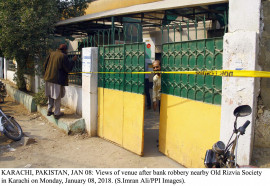
Recently, the State Bank of Pakistan readjusted the exchange rate, allowing the rupee to drop against the dollar by 5.21% . The rupee fell from 105.21 in July 2017 to 110.7 on January 1st 2018. This was done in response to the IMF’s persistent suggestions to let the rupee float as per the market conditions to harness the widening trade gap that Pakistan is experiencing.
One may wonder how depreciation of the currency may affect the Pakistani population. Falling value of the rupee would increase the import prices denominated in rupee by the percentage of depreciation, ie, 5.21%. As an immediate impact, unemployment will worsen due to the increased per unit cost. To rationalise costs, some companies may even choose to go for a large-scale workforce redundancy.
The travel and tourism sector accounting for about 7% of GDP is expected to gain from depreciation. Depreciation will increase the demand for handicrafts, restaurant meals and local transport, boosting the income of locals involved in providing goods and services to tourists. An increase in nominal wages by the government is another dimensional impact of depreciation.
However, such sudden changes in exchange rate policies also have wide-ranging impacts on the social wellbeing in terms of equity and justice. On a micro-scale, a hike in the dollar price may translate into higher costs of rents, meal, tuition fee, air travel and the burden of student loan for Pakistani students studying abroad. The higher prices of imported medical equipment will increase the cost of medical treatment for the poor.
The net impact of rupee depreciation is different for different purchases and for men and women. Women get less benefit than men because women are often involved in the agriculture sector and will have to face higher costs of transport, fertiliser and other imported inputs. This in turn increases the food prices which again may hurt the women more than the men, as they are responsible for feeding the family within the household.
The real estate sector has a tendency to experience a boom with the rupee depreciation if foreign investments increase. Expats will find it cheaper to invest in real estate in Pakistan which will encourage the dollar inflow to the country. The depreciation would provide a psychological boost to both expatriates and developers. Developers will concentrate on their marketing efforts to attract more non-resident Pakistanis who will then enjoy the rupee depreciation and invest in real estate in order to enjoy better appreciation in the long term.
Nevertheless, the falling rupee will also increase the project cost and time frame followed by increased prices of necessary raw material, transport, labour wages, engineers, outsourced services in the form of design consultancy, architects, import of construction equipment, etc. Since a major portion of the labour force is employed in the real estate sector, a declining demand for property due to depreciation will not only affect the economy, but also the labour market.
There is a need for offsetting measures to protect some vulnerable groups, to implement the desired policy and to target the vulnerable segments of society either by giving temporary and well-targeted subsidies, or, through adjustment of the tax component in such a way that it enables more gradual pass-through of the exchange rate related in key commodity prices or via a differentiated wage policy in the formal sector. In this regard the following policy options are worth considering.
A tight fiscal position is necessary to control the increase in aggregate demand and the unnecessary increase in inflation which hits the poor more than the rich. The government needs to keep the food prices fixed through an economy wide price control, so that the poor segment of society may not be worse off in terms of increased spending on basic necessities of life. The policy that the government can use to support the vulnerable groups is to raise the income supplement, ie, to increase the income transfer to the poor population, those who are poor before the depreciation and those who became poor after the depreciation because of an increase in food prices.
Published in The Express Tribune, January 17th, 2018.
Like Opinion & Editorial on Facebook, follow @ETOpEd on Twitter to receive all updates on all our daily pieces.
































































COMMENTS
Comments are moderated and generally will be posted if they are on-topic and not abusive.
For more information, please see our Comments FAQ